Incorporating Charging/Discharging Strategy of Electric Vehicles into Security-Constrained Optimal Power Flow to Support High Renewable Penetration
Abstract
:1. Introduction
2. Carbon Free Island Initiative by 2030 in Jeju
3. Mathematical Formulation
3.1. Optimization Problem
• Power balancing constraint in the day-ahead market
• Power balancing constraint in the real-time market
• Generating unit constraints
• Branch/transformer and bus constraints
• EV fleet constraints
3.2. Grid Intergration of Renewable Energy Source
3.2.1. Effective Inertia Constant
3.2.2. Maximum Wind Power Penetration Limit
4. Case Study
4.1. System Configuration
4.1.1. Wind Power Generation
4.1.2. Load Profile and EV Modeling
4.1.3. Cost Function of Generating Units
4.1.4. EVs and RES Controls
4.2. Simulation Results
- w/o Control,
- Control 1: waiting mode,
- Control 2: charging mode,
- Control 3: charging and discharging mode.
5. Conclusions
Acknowledgments
Author Contributions
Conflicts of Interest
Nomenclature
Day ahead | |
Real time | |
Generation cost of conventional unit | |
Operating cost of EV fleets | |
Total generation | |
Active power output of conventional unit | |
Active power output of wind power unit | |
Active power output of solar power unit | |
Total demand | |
Demand except EV loads | |
Demand of EV fleets | |
Active power output variation of conventional unit in real time | |
Ramp rate of conventional unit | |
Maximum active power limit of conventional unit | |
Minimum active power limit of conventional unit | |
Maximum active power limit of wind power unit | |
Minimum active power limit of wind power unit | |
Maximum active power limit of solar power unit | |
Minimum active power limit of solar power unit | |
Number of conventional units | |
Number of wind power units | |
Number of solar power units | |
Number of EV fleets | |
MVA flow on line | |
MVA flow limit on line | |
| V | Voltage magnitude |
Allowable maximum voltage magnitude | |
Allowable Minimum voltage magnitude | |
Number of EVs | |
Number of EVs in charging mode | |
Number of EVs in discharging mode | |
Number of EVs in waiting mode | |
Number of unplugged EVs | |
| B | Battery capacity of EV fleet |
| C | Charging of EV fleet |
| D | Discharging of EV fleet |
| SOC | State of charge |
Charging efficiency of EV battery | |
Discharging efficiency of EV battery | |
Effective inertia constant | |
| H | Rotational inertia constant of conventional unit |
MVA rating of unit | |
HVDC power transfer |
References
- Richardson, D.B. Electric vehicles and the electric grid: A review of modeling approaches, impacts, and renewable energy integration. Renew. Sust. Energy Rev. 2013, 19, 247–254. [Google Scholar] [CrossRef]
- Fang, X.; Misra, S.; Xue, G.; Yang, D. Smart grid—The new and improved power grid: A survey. IEEE Commun. Surv. Tutor. 2012, 14, 944–980. [Google Scholar] [CrossRef]
- Electric Power System Flexibility: Challenges and Opportunities; Technical Report 3002007374; Electric Power Research Institute (EPRI): Palo Alto, CA, USA, 2016.
- Lund, H.; Kempton, W. Integration of renewable energy into the transport and electricity sectors through V2G. Energy Policy 2008, 36, 3578–3587. [Google Scholar] [CrossRef]
- Vaya, M.G.; Andersson, G. Self scheduling of plug-in electric vehicle aggregator to provide balancing services for wind power. IEEE Trans. Sustain. Energy 2016, 7, 886–899. [Google Scholar] [CrossRef]
- Carrion, M.; Zarate-Minano, R. Operation of renewable-dominated power systems with a significant penetration of plug-in electric vehicles. Energy 2015, 90, 827–835. [Google Scholar] [CrossRef]
- Yilmaz, M.; Krein, P.T. Review of the impact of vehicle-to-grid technologies on distribution systems and utility interfaces. IEEE Trans. Power Electron. 2013, 28, 5673–5689. [Google Scholar] [CrossRef]
- Shafiee, S.; Fotuhi-Firuzabad, M.; Rastegar, M. Investigating the impacts of plug-in hybrid electric vehicles on power distribution systems. IEEE Trans. Smart Grid 2013, 4, 1351–1360. [Google Scholar] [CrossRef]
- Ortega-Vazquez, M.A.; Bouffard, F.; Silva, V. Electric vehicle aggregator/system operator coordination for charging scheduling and services procurement. IEEE Trans. Power Syst. 2013, 28, 1806–1815. [Google Scholar] [CrossRef]
- Schuller, A.; Dietz, B.; Flath, C.M.; Weinhardt, C. Charging strategies for battery electric vehicles: Economic benchmark and V2G potential. IEEE Trans. Power Syst. 2014, 29, 2014–2022. [Google Scholar] [CrossRef]
- Sharma, I.; Cañizares, C.; Bhattacharya, K. Smart charging of PEVs penetrating into residential distribution systems. IEEE Trans. Smart Grid 2014, 5, 1196–1209. [Google Scholar] [CrossRef]
- Zhou, L.; Li, F.; Gu, C.; Hu, Z.; Blond, S.L. Cost/benefit assessment of a smart distribution system with intelligent electric vehicle charging. IEEE Trans. Smart Grid 2014, 5, 839–847. [Google Scholar] [CrossRef]
- Tuttle, D.P.; Baldick, R. The Evolution of plug-in electric vehicle-grid interactions. IEEE Trans. Smart Grid 2012, 3, 500–505. [Google Scholar] [CrossRef]
- Deilami, S.; Masoum, A.S.; Moses, P.S.; Masoum, M.A.S. Real-time coordination of plug-in electric vehicle charging in smart grids to minimize power losses and improve voltage profile. IEEE Trans. Smart Grid 2011, 2, 456–467. [Google Scholar] [CrossRef]
- Chukwu, U.C.; Mahajan, S.M. Real-time management of power systems with V2G facility for smart-grid applications. IEEE Trans. Sustain. Energy 2014, 5, 558–566. [Google Scholar] [CrossRef]
- Energy and Climate Change; Technical Report; International Energy Agency (IEA): Paris, France, 2015.
- Boyd, R.; Turner, J.; Ward, B. Tracking intended nationally determined contributions: what are the implications for greenhouse gas emissions in 2030; Policy Paper; Centre for Climate Change Economics and Policy and Grantham Research Institute on Climate Change and the Environment: London, UK, 2015. [Google Scholar]
- Boot, P.A.; van Bree, B. A Zero-Carbon European Power System in 2050: Proposals for a Policy Package; Technical Report ECN-E-10-041; Energy Research Centre of The Netherlands (ECN): Petten, The Netherlands, 2010. [Google Scholar]
- Korea Smart Grid Institute. Available online: www.smartgrid.or.kr (accessed on 27 March 2017).
- Smart grid in Korea; Technical Report; Ministry of Knowledge Economy and Korea Smart Grid Institute: Seoul, Korea, 2013.
- Carbon Free Island Jeju by 2030; Technical Report; Ministry of Knowledge Economy and Korea Smart Grid Institute: Seoul, Korea, 2015.
- Kundur, P. Power System Stability and Control; McGraw-Hill: New York, NY, USA, 1994. [Google Scholar]
- Papathanassiou, S.; Boulaxis, N. Power limitations and energy yield calculation for wind farms operating in island systems. Renew. Energy 2006, 31, 457–479. [Google Scholar] [CrossRef]
- Park, J.W.; Park, Y.H.; Moon, S.I. Instantaneous wind power penetration in Jeju Island. In Proceedings of the Power and Energy Society General Meeting—Conversion and Delivery of Electrical Energy in the 21st Century, Pittsburgh, PA, USA, 2008. [Google Scholar]
- Yoon, M.; Yoon, Y.T.; Jang, G. A study on maximum wind power penetration limit in island power system considering high-voltage direct current interconnections. Energies 2015, 8, 14244–14259. [Google Scholar] [CrossRef]
- Ott, A.L. Experience with PJM market operation, system design, and implementation. IEEE Trans. Power Syst. 2003, 18, 528–534. [Google Scholar] [CrossRef]
- Wu, T.; Rothleder, M.; Alaywan, Z.; Papalexopoulos, A.D. Pricing energy and ancillary services in integrated market systems by an optimal power flow. IEEE Trans. Power Syst. 2004, 19, 339–347. [Google Scholar] [CrossRef]
- Duvall, M.; Knipping, E.; Alexander, M. Environmental Assessment of Plug-in Hybrid Electric Vehicles-Nationwide Greenhouse Gas Emissions; Technical Report 1015325; Electric Power Research Institute (EPRI): Palo Alto, CA, USA, 2007. [Google Scholar]
- The 7-th Basic Plan for Long Term Electricity Supply & Demand (2015–2029); Technical Report; Ministry of Knowledge Economy: Seoul, Korea, 2015.
- Analysis for Impact of EVs and Wind Power Plants on Jeju Power System; Technical Report; Korea Power Exchange: Jeju Island, Korea, 2016.
- National Climate Data Service System of South Korea. Available online: http://sts.kma.go.kr/ (accessed on 27 March 2017).
- Medium & Long Term Comprehensive Plan for Electric Vehicles (2015–2030); Technical Report; Jeju Special Self-Governing Province: Jeju Island, Korea, 2015.
- Zimmerman, R.D.; Murillo-Sanchez, C.E.; Thomas, R.J. MATPOWER’s extensible optimal power flow architecture. In Proceedings of the 2009 IEEE Power Energy Society General Meeting, Calgary, AB, Canada, 2009. [Google Scholar]
- A Research of EV Charging Infrastructure Distribution; Technical Report; Korea Smart Grid Institute: Seoul, Korea, 2011.
- Kim, J.H.; Kim, C.H. Smart EVs charging scheme for load leveling considering ToU price and actual data. J. Electr. Eng. Technol. 2017, 12, 1–10. [Google Scholar] [CrossRef]

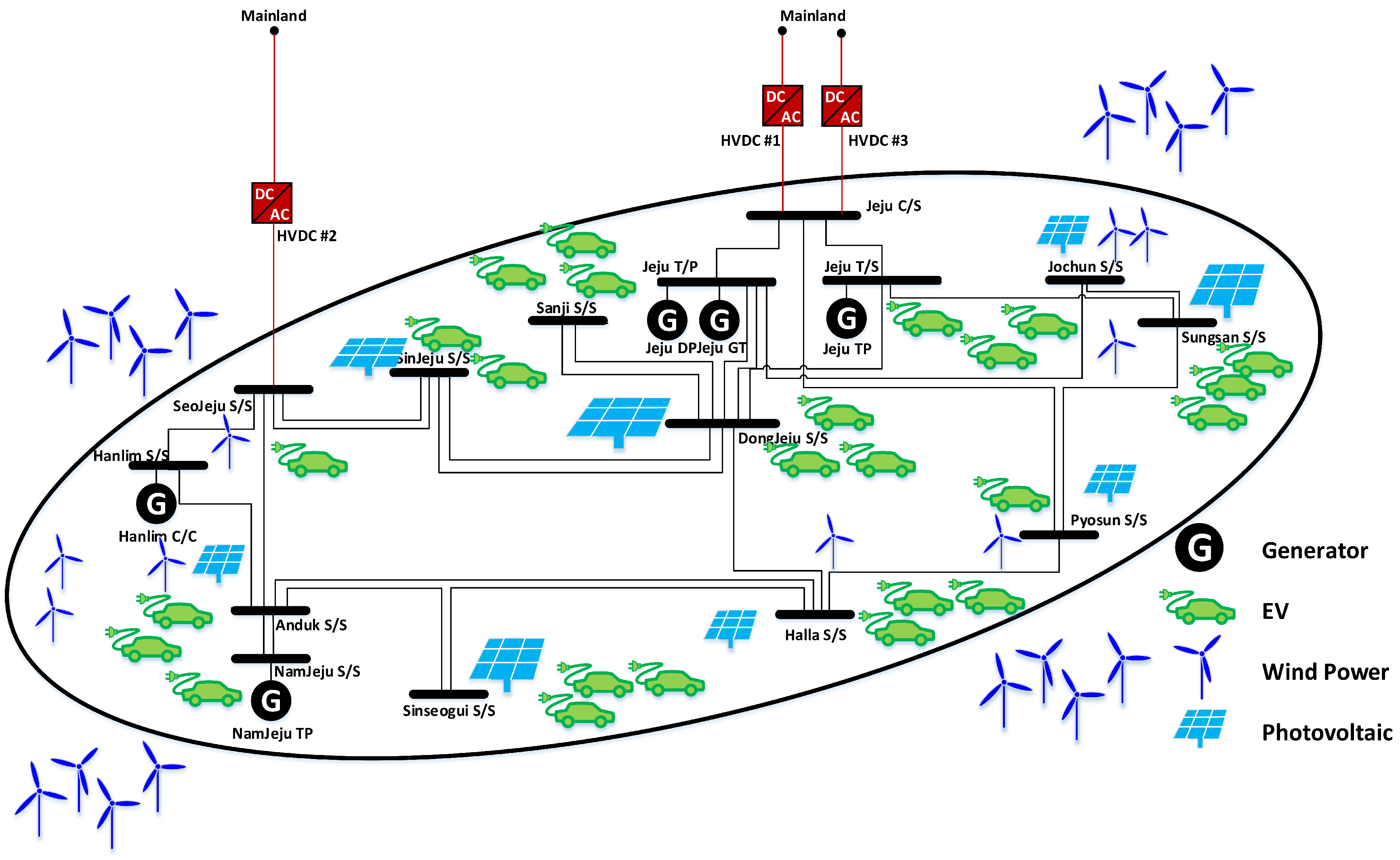
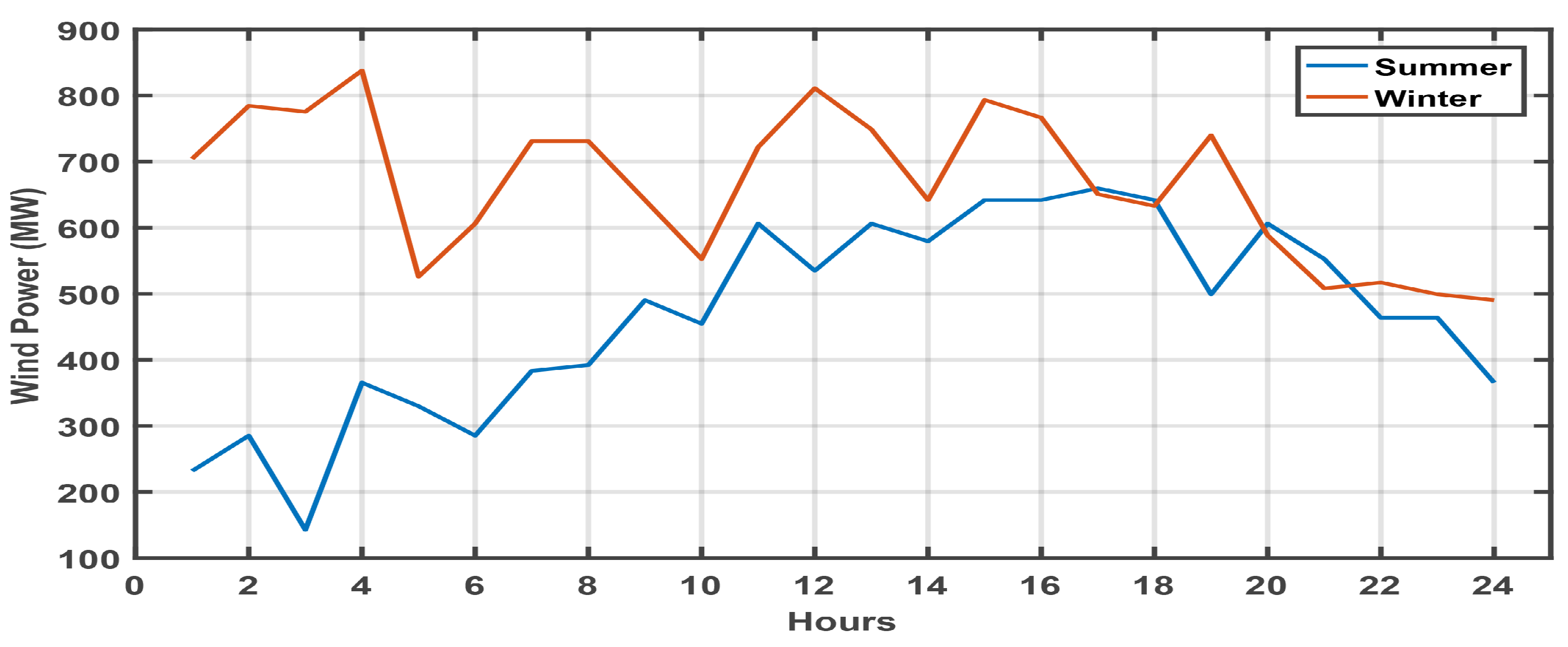
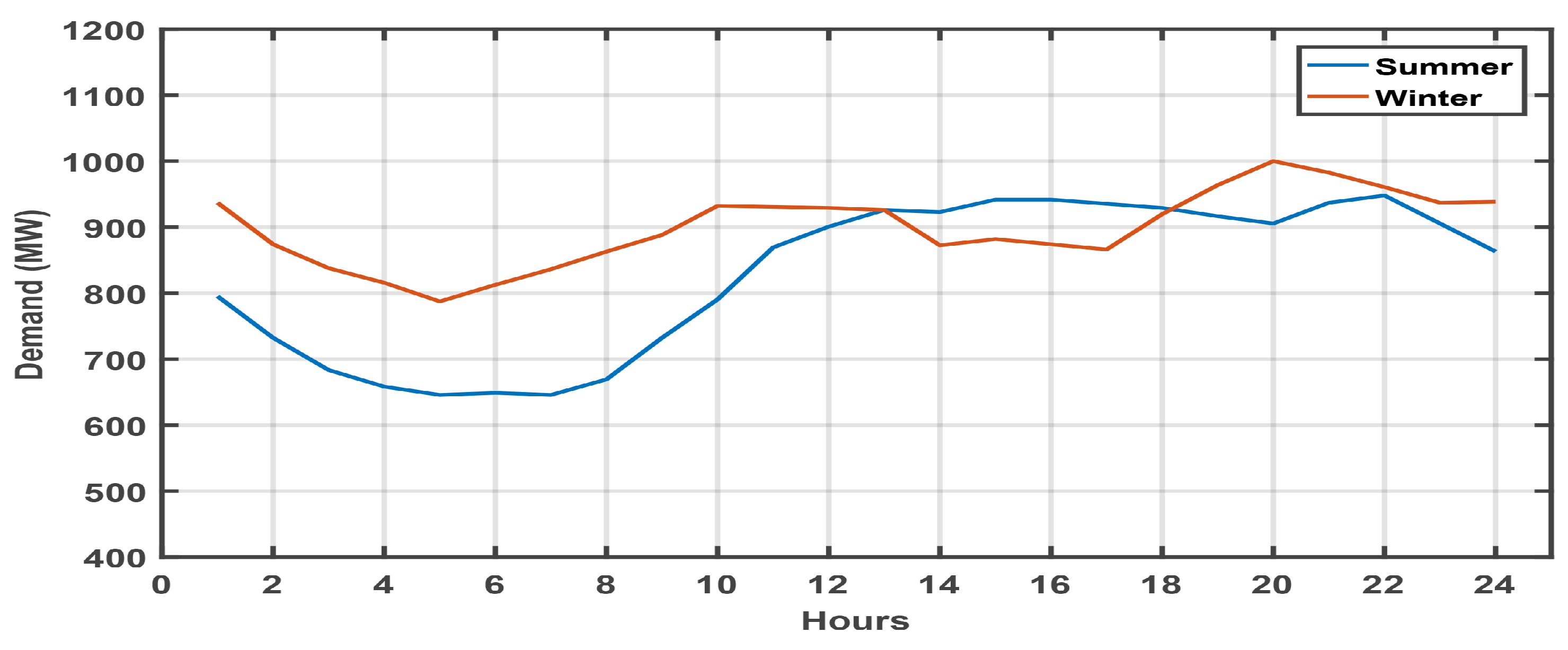
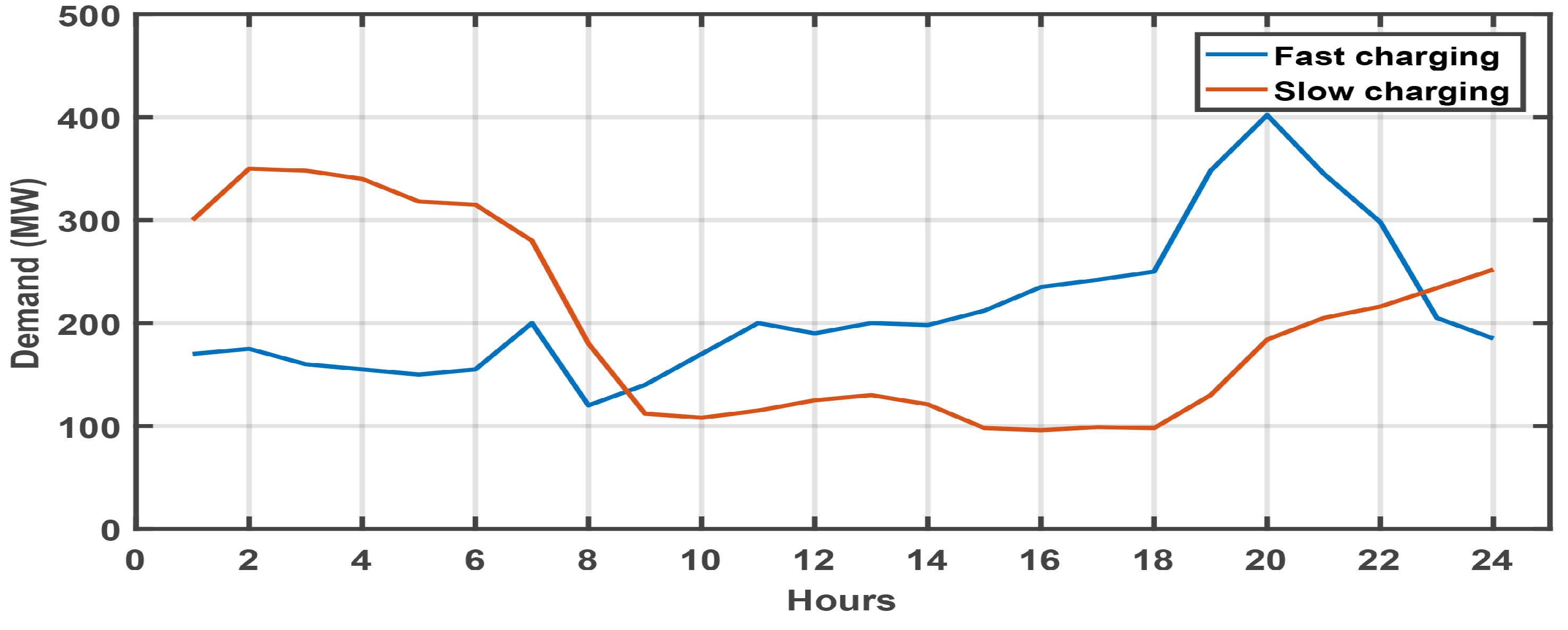
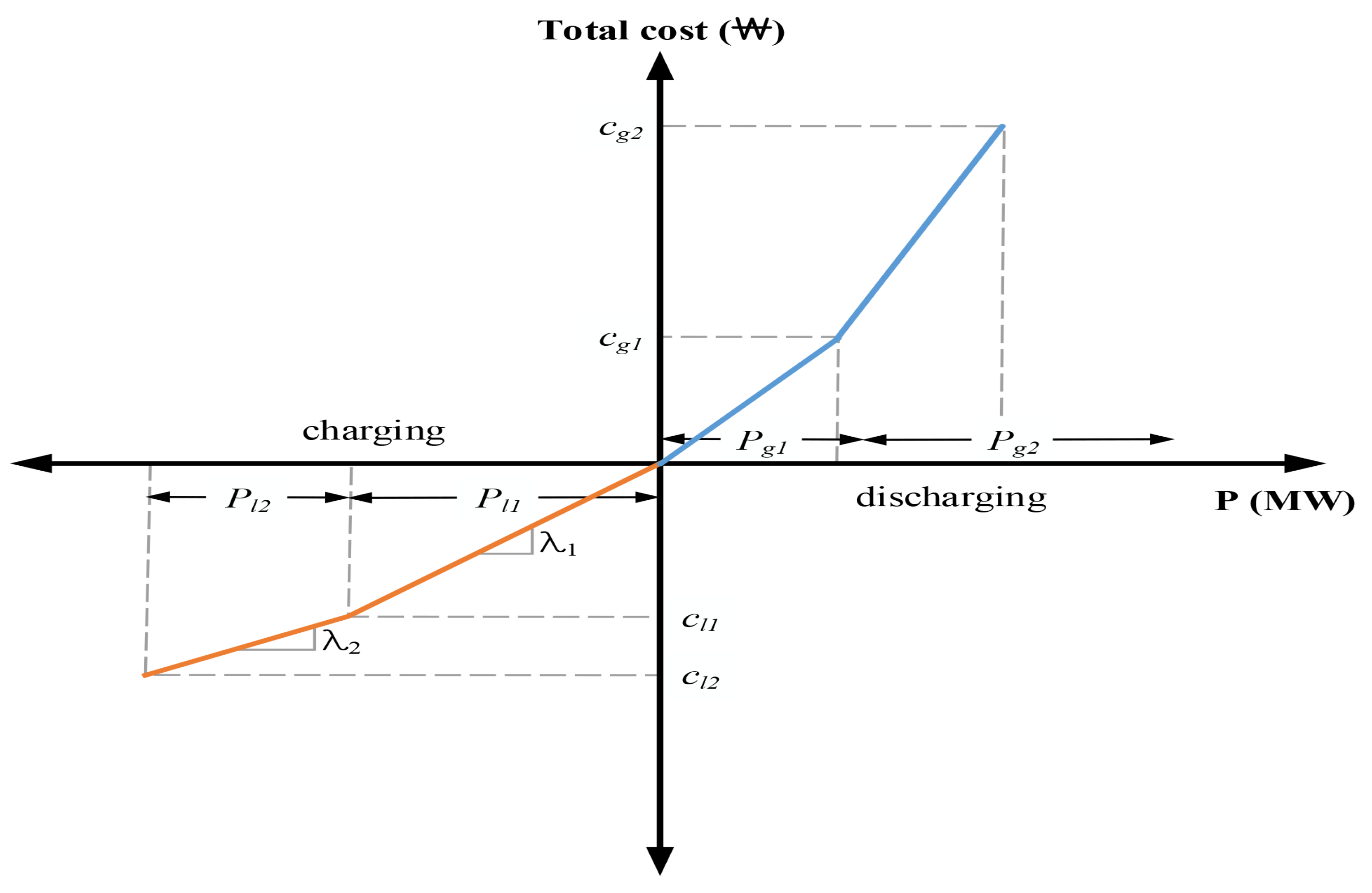
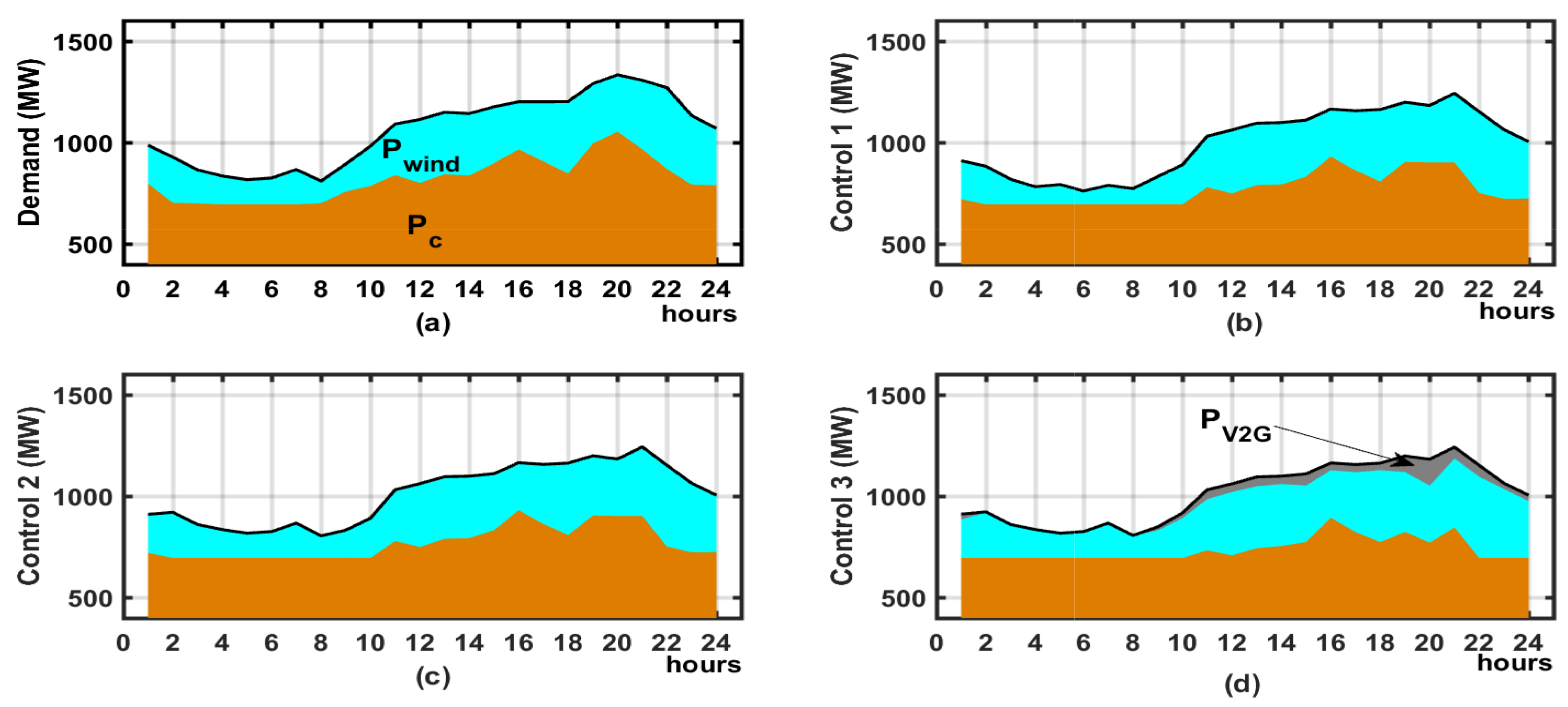

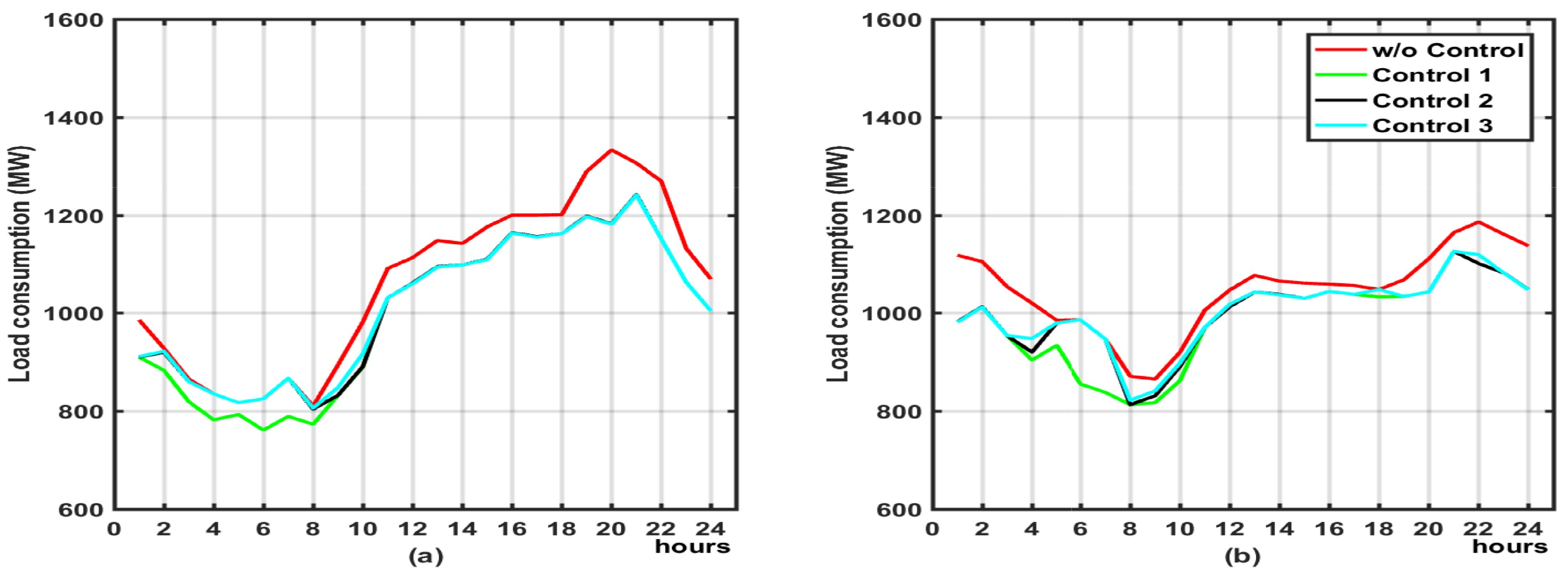
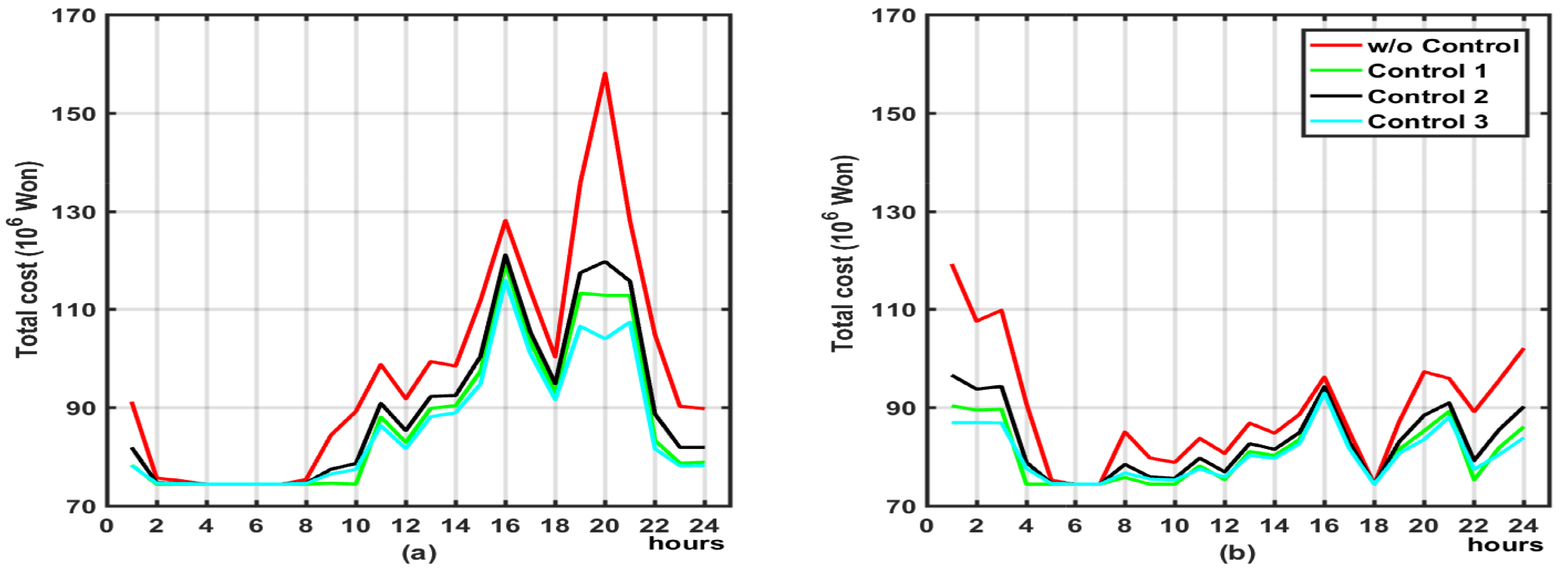
| Generator | (MW) | (MW) | Inertia (H) | R.R (MW/min) | Rating (MVA) |
|---|---|---|---|---|---|
| Jeju GT #1 | - | - | 2.6 | - | 50 |
| Jeju GT #2 | - | - | 2.6 | - | 50 |
| Jeju DP #1 | 26 | 40 | 6.7 | 2.0 | 45 |
| Jeju DP #2 | 26 | 40 | 6.7 | 2.0 | 45 |
| Jeju TP #1 | 42 | 75 | 5.4 | 1.0 | 97 |
| Jeju TP #2 | 42 | 75 | 5.4 | 1.0 | 97 |
| NamJeju TP #1 | 50 | 100 | 5.9 | 5.0 | 130 |
| NamJeju TP #2 | 50 | 100 | 5.9 | 5.0 | 130 |
| Hanlim CC | 41 | 105 | 6.0 | 8.7 | 150 |
| Jeju LNG | 60 | 200 | 6.0 | 5.0 | 250 |
| Total | 337 | 735 | - | 29.7 | - |
© 2017 by the authors. Licensee MDPI, Basel, Switzerland. This article is an open access article distributed under the terms and conditions of the Creative Commons Attribution (CC BY) license (http://creativecommons.org/licenses/by/4.0/).
Share and Cite
An, K.; Song, K.-B.; Hur, K. Incorporating Charging/Discharging Strategy of Electric Vehicles into Security-Constrained Optimal Power Flow to Support High Renewable Penetration. Energies 2017, 10, 729. https://doi.org/10.3390/en10050729
An K, Song K-B, Hur K. Incorporating Charging/Discharging Strategy of Electric Vehicles into Security-Constrained Optimal Power Flow to Support High Renewable Penetration. Energies. 2017; 10(5):729. https://doi.org/10.3390/en10050729
Chicago/Turabian StyleAn, Kyungsung, Kyung-Bin Song, and Kyeon Hur. 2017. "Incorporating Charging/Discharging Strategy of Electric Vehicles into Security-Constrained Optimal Power Flow to Support High Renewable Penetration" Energies 10, no. 5: 729. https://doi.org/10.3390/en10050729
APA StyleAn, K., Song, K.-B., & Hur, K. (2017). Incorporating Charging/Discharging Strategy of Electric Vehicles into Security-Constrained Optimal Power Flow to Support High Renewable Penetration. Energies, 10(5), 729. https://doi.org/10.3390/en10050729







